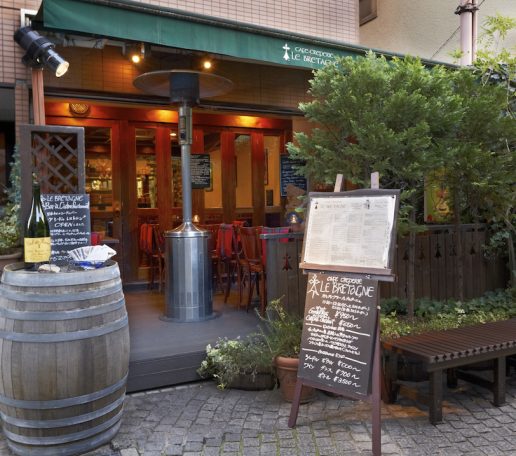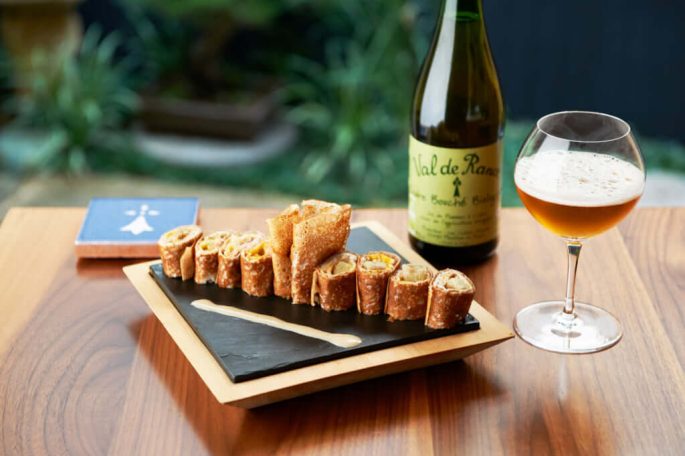Crepe
Since the dawn of time, people all over the world have prepared wafer-type flatbread dishes made from cereal or legume flour to accompany their meals. The galette was a thick pancake, made with a dough mixing water and various flours, and baked on a hot stone. Historians date the origins of the galette back to 7000 BC.
Examples of this dish include Cong You Bing in China, Paratha in South Asia, Chapati in India, Pita in the Middle East, Injera in Ethiopia, Tortilla in Mexico, Galette and then Crepe in Europe, and later Pancake in the United States.
The Romans celebrated the Lupercalia festival with thick pancakes baked on hot stones at the beginning of February, to call upon the fertility of the earth for an abundant harvest with the coming of spring. In 494, Pope Gelasius transformed this festival into a Christian tradition celebrated on February 2: Chandeleur also known as Candlemas. In France, Candlemas is still celebrated in many families with crepes.
The crepe, or French galette, much thinner than the Roman version, first appeared in Brittany around the 13th century, following the cultivation of buckwheat brought back from the crusades in Asia. Initially made with buckwheat, it was transformed into the crepe made with white wheat flour (soft wheat flour) at the beginning of the 20th century.
International icons, crepes are identified worldwide as part of French cuisine.
They can be the main course of a meal (buckwheat pancakes with egg, ham and cheese, for example), the dessert (the famous "Crêpe Suzette" made with Grand-Marnier), or simply eaten as a snack during the day (sweet wheat pancakes). They are most often eaten at home, since the recipe is so simple, or in restaurants, but also at festivals such as Breton fairs or fest-noz. For a full meal of crepes, it's traditional to go to a Breton "crêperie", where they'll be served with cider.
In France, the sweet crepe is a delicacy served with sugar, jam, chocolate or caramel paste, as well as fruit, sometimes topped with whipped or Chantilly cream.
If you go to the Harajuku district of Tokyo, Japan, you'll find crowds of people strolling around and enjoying the many variations of the Japanese version of this iconic French dish.
Origins of the Japanese crepe
Crepes first appeared in Harajuku as a street food in the 1970s. These Japanese crepes "Kureepu" (クレープ in Japanese) are very thin, wrapped in cone-shaped paper and, above all, contain a variety of unusual fillings. They're made from a mixture of wheat and rice flour and can be topped with savory or sweet products. Through the use of a utensil to spread the batter on the pan or griddle, Japanese crepes can be made as thin as paper. Unlike French crepes, Japanese crepes are almost exclusively outdoor treats, most often sold in food stalls and eaten on the street as snacks.
The design and wide variety of fillings are what make Japanese crepes so different from French crepes. Turning them from a dish served at the table to a product to be consumed on the go, the Japanese have given them a new lease of life by bringing them to the "Faasutofuudo" scene (ファーストフード in Japanese), the fast-food scene.

From left to right. Japanese crepes from ROCCA & Friends in the following flavors: candied chestnut; whipped cream and forest fruits; crème brulée and exotic fruits with slivered almonds.
The rise of the Japanese crepe
While French crepes had already been introduced to Japan, it wasn't until the second half of the 1970s that we saw the commercial emergence of modern Japanese crepes. At the time, the standard Japanese crepe was still similar to French-style crepes, with a hot crepe topped with fruit jam or chocolate sauce served as part of a restaurant menu.
It was in 1976 that the first street crepe stand opened in Tokyo, "Marion Crêpe", a brand that quickly became popular throughout the country. It was the first store in Japan to specialize in street crepes. "Marion Crepe" set the modern standard for crepes in Japan, selling them directly as a snack that could be eaten while walking.
A year later, in 1977, Marion Crêpe also opened a store on Takeshita Street in Harajuku, Tokyo. Today, this street is often associated with Japanese crepes, due to its high concentration of crepe stores.

MARION CRÊPES storefront
The same year, the "Café Crêpe" franchise opened its first store on Takeshita Street, under the name Blueberry House. Although at first this franchise did not attract much attention, this soon changed when, in the summer of 1979, they decided to add ice cream as a topping inside the crepe. This idea proved to be the turning point that drew all eyes to these new Harajuku-style crepes. Fruit is then added as a complement, along with whipped cream and various other toppings.

A display of plastic crepes representing some of the different flavors available.
The Harajuku crepe concept quickly caught on and became what we know today as Japanese crepes. The combination of these two franchises' ideas - taking pancakes out onto the streets and offering new toppings - gave birth to a whole new crepe culture in a country thousands of miles from its place of origin.
The rise of the French crepe in Japan.
As early as 1996, Le Bretagne restaurant in Tokyo was the first to introduce Japan to the art of French-style crepes and galettes.
It's in the heart of a small alleyway in the Kagurazaka district, "the Montmartre of Japan", that you'll find the very first "French crêperie" in the country: "Le Bretagne", a name and a home port chosen 27 years ago by Bertrand Larcher. He created the first "Breizh Café", offering sweet and raw cider with his crepes and galettes.
A winning formula, as a dozen "Breizh Cafés" now dot the Japanese territory, the latest having opened in Fukuoka. A cider bar has also sprung up in a traditional Tokyo house, and a delicatessen offers cookies, salted butter caramels and Breizh Cola. "We're the first distributor of French cider in Japan," confides Bertrand Larcher, taking stock of how far things have progressed.
Side note: Bertrand Larcher's first restaurant, Le Bretagne, was opened in Tokyo, Japan, in 1995. In 2003, he opened a restaurant in Fougères, Brittany, close to the family farm. It wasn't until 2004 that he launched the "Breizh Cafés" chain, with the first in Cancale, Brittany. Then came Paris, Nagoya, Yokohama, etc.
The emergence of the "Harajuku" crepe in France.
If you're in the mood for those superb cone-shaped Japanese crepes topped with ice cream, cheesecake and other delights, as found in Harajuku in the suburbs of Tokyo, then head for Paris and the 1st and 4th arrondissements.
With "Comptoir Harajuku" and "Princess Crepe", welcome to the kawaii world of Harajuku without leaving mainland France.
You can compose your own crepe, sweet or savory, with whipped cream, chocolate, red beans, cake, fruit, matcha and even karaage (Japanese fried chicken). Each season has its own themed crepe: for Halloween, for example, it's the pumpkin crepe.

Comptoir Harajuku storefront: 53 Rue Saint-Roch, 75001 Paris
At the "Comptoir Harajuku" in Paris, served with a variety of beverages, typically Japanese savoury dishes such as okonomiyakis (Japanese omelettes) or onigiris (stuffed rice dumplings), these offered crepes with multiple flavours are the Japanese appropriation of French crepes transfered back to France.
Harajuku crepes, Fench crepe or Breton galette - which one shall you fall in love with?












